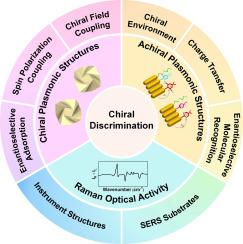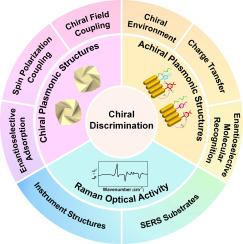手性鉴别的拉曼光谱技术:现状与新前沿
IF 23.5
1区 化学
Q1 CHEMISTRY, INORGANIC & NUCLEAR
引用次数: 0
摘要
手性鉴别在药物安全、催化、材料科学和环境可持续性方面至关重要,因为对映体通常表现出独特的生物、化学和物理性质。拉曼光谱技术通过操纵拉曼激发和散射光,建立了有效的对映体识别策略,以及构建手性分子识别系统和手性表面增强拉曼光谱(SERS)底物,具有无损、无标记和实时分析的优点。本文系统地综述了拉曼光谱技术鉴别对映体的原理和最新进展。本文首先介绍了拉曼光学活性(ROA)的基本机理和实验进展,强调了其在对映体识别中的重要性。超越基于roa的方法中使用的复杂仪器,我们讨论了通过将等离子体结构与传统拉曼光谱仪相结合在对映体识别方面的关键突破。总结了通过非手性和手性等离子体结构来区分对映体的新策略,特别强调了手性等离子体结构在对映选择性SERS中的潜在机制。最后,我们提出了这一不断发展的领域面临的主要挑战和未来的机遇,并对未来的发展方向提出了见解。本文章由计算机程序翻译,如有差异,请以英文原文为准。


Raman spectroscopic technologies for chiral discrimination: Current status and new frontiers
Chiral discrimination is crucial in drug safety, catalysis, materials science, and environmental sustainability, as enantiomers often exhibit distinct biological, chemical, and physical properties. Raman spectroscopic technologies have established efficient strategies for discriminating enantiomers through manipulating the Raman excitation and scattering light, as well as constructing chiral molecular recognition systems and chiral surface-enhanced Raman spectroscopy (SERS) substrates, which offer the advantages of non-destructive, label-free, and real-time analysis. This review systematically summarizes the principles and recent advances in Raman spectroscopic technologies for discriminating enantiomers. We begin by introducing the fundamental mechanisms and experimental progress of Raman optical activity (ROA), highlighting its importance in enantiomeric discrimination. Moving beyond the complex instruments used in ROA-based methods, we discuss critical breakthroughs in enantiomeric discrimination by combining plasmonic structures with conventional Raman spectrometers. The emerging strategies to discriminate enantiomers by both achiral and chiral plasmonic structures are summarized, with particular emphasis on the underlying mechanisms of chiral plasmonic structures in enantioselective SERS. Finally, we present the major challenges and future opportunities in this evolving field, providing insights into the future development directions.
求助全文
通过发布文献求助,成功后即可免费获取论文全文。
去求助
来源期刊

Coordination Chemistry Reviews
化学-无机化学与核化学
CiteScore
34.30
自引率
5.30%
发文量
457
审稿时长
54 days
期刊介绍:
Coordination Chemistry Reviews offers rapid publication of review articles on current and significant topics in coordination chemistry, encompassing organometallic, supramolecular, theoretical, and bioinorganic chemistry. It also covers catalysis, materials chemistry, and metal-organic frameworks from a coordination chemistry perspective. Reviews summarize recent developments or discuss specific techniques, welcoming contributions from both established and emerging researchers.
The journal releases special issues on timely subjects, including those featuring contributions from specific regions or conferences. Occasional full-length book articles are also featured. Additionally, special volumes cover annual reviews of main group chemistry, transition metal group chemistry, and organometallic chemistry. These comprehensive reviews are vital resources for those engaged in coordination chemistry, further establishing Coordination Chemistry Reviews as a hub for insightful surveys in inorganic and physical inorganic chemistry.
 求助内容:
求助内容: 应助结果提醒方式:
应助结果提醒方式:


